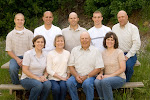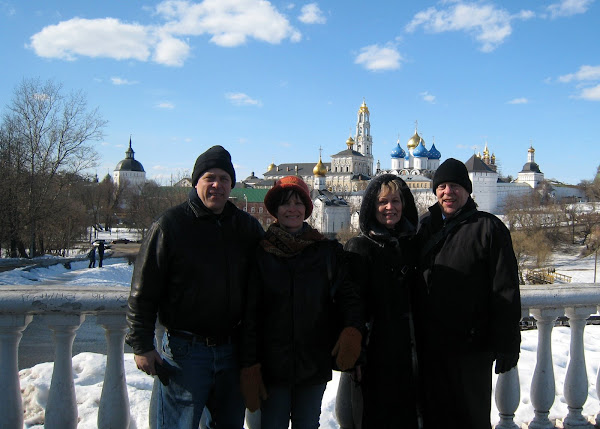Narene & Sam on the shore of the Baltic Sea.
We flew from Moscow very early on June 30, going to the Baltics to do welfare and humanitarian training in Riga and Liepaja in Latvia and in Kaunas in Lithuania. Sam also had a training session via a conference call with leaders in Estonia. We returned to Moscow July 4 about 10:00 p.m. Since we had some free time in each location, we have photos to share on the blog. Riga will be the focus in Part 1 of a three-part blog remembering our trip to the Baltics.
 Welcome to Riga, Latvia
Welcome to Riga, LatviaWe spent the first day in Riga walking around and taking pictures, as the meetings didn't start until the next day. Opting for the cheapest flight required us to get up very early that morning, but it also gave us a day of sightseeing in a very quaint city. We began our walk through the large outdoor market.
 A large variety of things were sold in the outdoor market -
A large variety of things were sold in the outdoor market -fresh fruit and vegetables, household items, clothing,
flowers, and more.
 We enjoyed seeing the beautiful flowers.
We enjoyed seeing the beautiful flowers.  Guided by a walking tour pamphlet, we saw the places
Guided by a walking tour pamphlet, we saw the placesof interest in Old Riga. This building is called the
Blackheads' House or the Melngalvju.
The Blackheads' House was originally built in 1344 as a merchant guild, but was destroyed during the war in 1941. It was rebuilt in 2001 keeping the structure and exterior like the original building. Today it is a museum and sometimes a concert hall.
A typical street in Riga and one of its many churches.
 St. Peter's Lutheran Church
St. Peter's Lutheran ChurchThis is the biggest church in Latvia,
first mentioned in historical documents in 1209.
St. Peter's was destroyed during WWII and renovated between 1967 and 1977. Church services have been renewed since 1991. The day we were there, it was closed so we did not get to go up into its high steeple for the panoramic view.
 Another view of St. Peter's Church.
Another view of St. Peter's Church.
St. John's Church was established in 1234
and named after John the Baptist.

 Entrance to St. John's Church.
Entrance to St. John's Church. A close-up of an upper part of St. John's Church.
A close-up of an upper part of St. John's Church. St. Jacob's Cathedral.
St. Jacob's Cathedral.First mentioned in 1225.
St. Jacob's was the first church to preach reformation, and the first Lutheran services for the Latvian congregation took place here. Today, St. Jacob's church is the cathedral of the Arch-Bishop of the Latvian Catholic Church.
Riga Dome Cathedral (Narene). The cornerstone was laid down in 1211.
The Dome Cathedral is one of the largest cathedrals in the Baltic States. It has been reconstructed a number of times, so many architectural styles have been used. It has stained glass windows and one of the biggest organs in Europe (6,768 pipes). Today, it is the home to a Lutheran parish, the Riga History and Shipping Museum, and functions as a concert hall.
The Riga Castle built in 1330. It is now home to museums as well as
the office and residence of the president of Latvia.
 The yellow tower is part of the castle on the other side.
The yellow tower is part of the castle on the other side.The Castle has been destroyed and rebuilt a number of times. It houses the Historical Museum of Latvia, the Museum of Foreign Art, and the Rainis' Literature and Art Museum.
 The "Cats' House"
The "Cats' House"At the beginning of the 20th century, the Latvian owner of the Cat House had statuettes made of the back ends of his two black cats with backs arched and tails up. He placed them on top of the building facing the Big Guild Hall across the road. The Guild was strictly for rich German traders and had refused him entry. After a lengthy court case, he was admitted into the Guild on the condition that he turn the cats around to face the front in a more respectful position.
 The Gun Powder Tower
The Gun Powder Tower
It gets its name from when it was used for storing
gunpowder in the 17th century.
Today, it houses the Latvian War Museum.
 The one in black is Sam; I don't know who the other guy is.
The one in black is Sam; I don't know who the other guy is.
 We went for a walk through this park.
We went for a walk through this park.
 Another park we saw from the bridge.
Another park we saw from the bridge.
 Freedom Monument erected in 1935
Freedom Monument erected in 1935
on a spot where a statue of
Peter the Great had stood.
 Grebenshchikov Church
Grebenshchikov Church
 The Orthodox Cathedral,
The Orthodox Cathedral,
built between 1876 and 1884.
It was turned into a planetarium during the Soviet era.
 Inside the Orthodox Cathedral.
Inside the Orthodox Cathedral.
The interior was renovated and remodeled
after the destruction by the Soviets during WWII.
 Looking up to the dome in the Orthodox Cathedral.
Looking up to the dome in the Orthodox Cathedral.
 Virgin of Anguish Catholic Church
Virgin of Anguish Catholic Church
 Many buildings have been restored, but not this one.
Many buildings have been restored, but not this one.
 Academy of Science,
Academy of Science,
which is similar to the Seven Sisters in Moscow.
 The "Three Brothers"
The "Three Brothers"
The oldest dwelling houses in Riga.
 A narrow cobbled stone street.
A narrow cobbled stone street.
 One of the cute decorations at Lido's restaurant where we ate supper.
One of the cute decorations at Lido's restaurant where we ate supper.
It was a long walk to get there, but the food was good.
For dessert, I had "cake" which was a dark rye bread
topped with fruit and whipped cream.
 The garden in front of Lido's Restaurant.
The garden in front of Lido's Restaurant.
 Communication Tower,
Communication Tower,
which we passed by on our walk to Lido's.
 An unusual bridge.
An unusual bridge.
Riga lies on the banks of the Daugava River
in the form of a circle.
 A brick archway and an old stone wall.
A brick archway and an old stone wall.
 A golden warrior.
A golden warrior.
 Street musicians.
Street musicians.
 The lady was weeding the flower beds
The lady was weeding the flower beds
and putting the weeds into her sack.
 Zone Conference with new Mission President Dance & his wife.
Zone Conference with new Mission President Dance & his wife.

 The Gun Powder Tower
The Gun Powder Tower It gets its name from when it was used for storing
gunpowder in the 17th century.
Today, it houses the Latvian War Museum.
 The one in black is Sam; I don't know who the other guy is.
The one in black is Sam; I don't know who the other guy is. We went for a walk through this park.
We went for a walk through this park. Another park we saw from the bridge.
Another park we saw from the bridge. Freedom Monument erected in 1935
Freedom Monument erected in 1935on a spot where a statue of
Peter the Great had stood.
In the late 1980s and early '90s, the Freedom Monument became a focus of the Latvian independence movement, which started on 14 June 1987, when 5,000 people rallied here.
 Grebenshchikov Church
Grebenshchikov Church The Grebenshchikov church has one of the largest congregations of Old Believers in the world, which is a sect that fled persecution in Russia in the 18th century according to a source I read. This is the only church with a golden dome in Riga.
 The Orthodox Cathedral,
The Orthodox Cathedral,built between 1876 and 1884.
It was turned into a planetarium during the Soviet era.
 Inside the Orthodox Cathedral.
Inside the Orthodox Cathedral. The interior was renovated and remodeled
after the destruction by the Soviets during WWII.
 Looking up to the dome in the Orthodox Cathedral.
Looking up to the dome in the Orthodox Cathedral. Virgin of Anguish Catholic Church
Virgin of Anguish Catholic ChurchWe've looked at a lot of churches in Riga, so now here are some other interesting buildings.
 Many buildings have been restored, but not this one.
Many buildings have been restored, but not this one. Academy of Science,
Academy of Science, which is similar to the Seven Sisters in Moscow.
 The "Three Brothers"
The "Three Brothers"The oldest dwelling houses in Riga.
The "Green Brother" is the youngest - middle of the 18th century.
The "Middle Brother's" year of birth - 1646, is written on the front.
The "White Brother" is the oldest (15th century).
It has stone benches on both sides of the door.
 A narrow cobbled stone street.
A narrow cobbled stone street. One of the cute decorations at Lido's restaurant where we ate supper.
One of the cute decorations at Lido's restaurant where we ate supper.It was a long walk to get there, but the food was good.
For dessert, I had "cake" which was a dark rye bread
topped with fruit and whipped cream.
 The garden in front of Lido's Restaurant.
The garden in front of Lido's Restaurant. Communication Tower,
Communication Tower, which we passed by on our walk to Lido's.
 An unusual bridge.
An unusual bridge.Riga lies on the banks of the Daugava River
in the form of a circle.
 A brick archway and an old stone wall.
A brick archway and an old stone wall. A golden warrior.
A golden warrior. Street musicians.
Street musicians. The lady was weeding the flower beds
The lady was weeding the flower bedsand putting the weeds into her sack.
 Zone Conference with new Mission President Dance & his wife.
Zone Conference with new Mission President Dance & his wife.President Dance and his family flew to Riga on the same plane we did, and we visited with them in the Moscow airport and in Riga. The next morning, President Dance presided at the welfare training meeting where Sam provided training for the district presidency. After the training meeting, we attended the zone conference and enjoyed watching President Dance meet his missionaries for the first time. The Dance's had two daughters with them, and their son flew in to join them having just completed his mission in Brazil. They have a nice family, and President Dance will be a good mission president.

After the zone conference, we went with Elder & Sister Boehm to eat at another Lido's in a different part of Riga. Elder Boehm is a counselor in the mission presidency, and he and his wife are also going to be involved with humanitarian projects around Liepaja. The next morning, Elder & Sister Boehm took us in their car to Kaunus, Lithuania and the following day to Liepaja, Latvia, where Sam provided more welfare training in both cities to district presidencides. Photos of Lithuania will be in Part 2 of our Baltics trip blog.










No comments:
Post a Comment